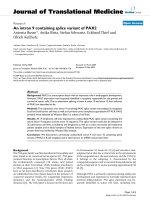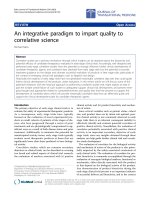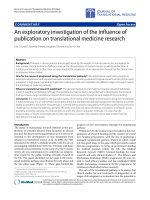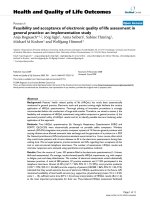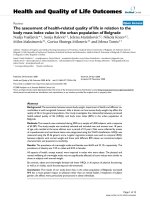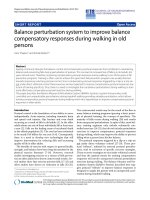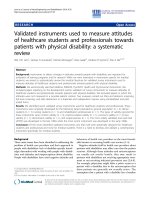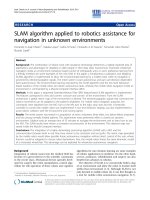Báo cáo hóa học: "An integrative paradigm to impart quality to correlative science" pdf
Bạn đang xem bản rút gọn của tài liệu. Xem và tải ngay bản đầy đủ của tài liệu tại đây (303.68 KB, 10 trang )
REVIEW Open Access
An integrative paradigm to impart quality to
correlative science
Michael Kalos
Abstract
Correlative studies are a primary mechanism through which insights can be obtained about the bioactivity and
potential efficacy of candidate therapeutics evaluated in early-stage clinical trials. Accordingly, well designed and
performed early-stage correlative studies have the potential to strongly influence further clinical development of
candidate therapeutic agents, and correlative data obtained from early stage trials has the potential to provide
important guidance on the design and ultimate successful evaluation of products in later stage trials, particularly in
the context of emerging clinical trial paradigms such as adaptive trial design.
Historically the majority of early stage trials have not generated meaningful correlative data sets that could guide
further clinical development of the products under evaluation. In this review article we will discuss some of the
potential limitations with the historical approach to performing correlative studies that might explain at least in
part the to-date overall failure of such studies to adequately support clinical trial development, and present emer-
ging thought and approaches related to comprehensiveness and quality that hold the promise to support the
development of correlative plans which will provide meaningful correlative data that can effectively guide and
support the clinical development path for candidate therapeutic agents.
Introduction
The primary objective of early stage clinical trials is to
evaluate the safety of experimental therapeutic products.
As a consequence, early stage trials have typically
focused on the evaluation of novel experimental pro-
ducts on small cohorts of patients at late stages of dis-
ease, who have progressed through a series of prior
treatments and are physiologically compromised in sig-
nificant ways as a result of both disease status and prior
treatment. Additionally, to minimize the potential for
unanticipated t oxicity issues, early stage trials typically
evaluate novel therapeutic products at doses that are
significantly lower than those predicted to have biologi-
cal activity.
Correlative studies, which are common secon dary
objectives in clinical trial s, can be described as covering
two broad and related aspects of clinical trial research:
the evaluation of markers associated with (i) positive
clinical activity and (ii) product bioactivity and mechan-
ism of action.
Since critical variables such as patient status, cohort
size, and product dose are by intent sub-opt imal, posi-
tive clinical activity is not commonly observed in early
stage trials there is an inherent consequent inability to
effectively identify and evaluate potential correlates of
positive clinical activity. Nonetheless, the evaluation of
correlates potentially associated with positive clinical
activity is an important secondary objective of early
stage trials, since any insights obtained through these
analyses can help guide further clinical trial and correla-
tive study development.
The evaluation of correlat es for the biological activity
and mec hanism of action of the products is also poten-
tially impacted by the safety-associated constraints o f
early clinical trials. The evaluat ion of correlat es for pro-
duct bioactivity is commonly accomplished through the
evaluation of surrogate biological markers, functional or
mechanistic, either directly associated with the p roduct
or that depend on the biologi cal activi ty of the product.
Any demonstration of product bioactivity during the
early stage clinical trial process is an important indicator
of successful delivery and bioactivi ty, and in the contex t
Correspondence:
Department of Pathology and Laboratory Medicine, University of
Pennsylvania School of Medicine, Abramson Family Cancer Research
Institute, University of Pennsylvania, 422 Curie Boulevard, BRBII/III,
Philadelphia, PA 19104-4283, USA
Kalos Journal of Translational Medicine 2010, 8:26
/>© 2010 Kalos; licensee BioMed Central Ltd. This is an Open Acces s article distributed under the terms of the Creative Commons
Attribution License ( which permits unrestricted use, distri bution, and reproduction in
any medium, provided the original work is properly cited.
of optimal biological dosing issues may help guide dos-
ing schedules. This is particularly relevant for subse-
quent trial design, since the optimal biological dose
(OBD) and dosing schedule of the product are likely to
be distinct from the maximum tolerated dose (MTD).
Early-stage insights into the biological effects of pro-
ducts are also i mportant to appropriately and efficiently
gui de the further clinical develop ment and validation as
surrogate clinical biomarkers for product bioactivity and
clinical efficacy. Finally, because at least a subset of can-
didate therapeutic products are likely to generate unan-
ticipated biological effects, both positive and negative, it
is also relevant to identify these effects in order to
further characterize and address their impact on treat-
ment outcome during later stage trials.
Robust and meaningful data about both product
bioactivity and clinical activity are critical in the context
of increasingly adopted adaptive trial design [1,2], which
is based on the use of baeysian statistics to analyse data
sets generated during the early stages of the clinical trial
and in turn implement changes to fundamental clinical
trial parameters such a s primary endpoints, patient
populations, cohort sizes and treatment arms, changes
in statistical methodologies and changes in trial objec-
tives [3,4].
Historically, the design of clinical correlative studies
has been based on the scientific principles of hypothesis
based experimentation which demands that research be
based on specifically defined and testable hypotheses.
The rationale and benefits of hypothesis-based research
are clear: such research efforts are explicitly defined and
focused, the ability to evaluate infrastructure and inves-
tigator capabilities is clear cut, and accountability for
accomplishing specific goals can be objectively
evaluated.
An unfortunate and unintended consequence of
basing correlative studies primarily on principles of
hypothesis based experimentation has been the estab-
lishment of a mind set that diminishes the value of
hypothesis generating experimentation. Because it is
impossible to have a comprehensive understanding of
how candidate therapeutic agents impact patient biology
from a whole systems perspective (Figure 1), our ability
to define and implement the most appropriate correla-
tive assays to evaluate candidate therapeutic agents is
inevitably compromised, if driven only by hypotheses
based on pre-existing biased views. Consequently, the
concept of clinical corre lative study design based solely
or principally on hypothesis-based experimentation is
fundamentally limiting, since it is destined to provide
information on only a small subse t of treatment asso-
ciated events-those for which we have a-priori knowl-
edge or insight. A complementary approach that ought
to be considered in conjunc tion with hypothesis-based
experimentation for clinical correlative studies involves
the d esign and application of platforms and assays that
are as broadly comprehensive as possible. Such an
approach would allow for the identificati on and capture
of a broad spectrum of data that have the potential to
provide critical insight into the bioactivity and biological
effects of the therapeutic moiet y being studied, and also
generate future testable hypotheses to be empirically
evaluated in subsequent studies.
Correlative studies-the past
Historically, five general principles have guided e arly-
stage clinical correlative study design: (i) They have
been dependent on the current state of knowledge
about the agent studied and the target cell/tissue/organ
(ii) They have been narrowly focused on parameters
considered to be directly associated with clinical efficacy
(iii) They have been based on the specific expertise and
interest of the principal investigator (iv) They have been
performed under gene ral research laboratory s tandar ds
in the laboratory of the clinical investigator directing the
trial and (v) They have been budget constrained.
It is perhaps fair to state this approach for conducting
correlative studies has failed, with precious few identifi-
able positive correlations established, even with low sta-
tistical significance, between disease impact and
evaluated correlates, and an equal absence of systemati c
information a bout the bioactivity of evaluated products
[5-9]. This is a remarkable, but nonetheless important
statement, as it underlines the fact that our to-date
approach for performing correlative studies suffers from
significant limitations. The nature of these limitations
and how we might move forward to overcome their
impact on clinical trial analyse s is the subject for the
remainder of this review.
One obvious and significant reason for the to-date
failure to identify m eaningful correlates of treatment
impact on disease and product bioactivity is related to
the limitations discussed above (patient status, product
dosing) imposed by the principal focus for early stage
trials on safety. Beyond these important limitations, the
general failure to identify biological correlates associated
with positive outcomes in early-stage clinical trials can
be attributed to two general possibilities: (i) the treat-
ment has no potential to mediate positive clinical out-
come and (ii) th e treatment has the potential to mediate
positive clinical outcomes, but those outcomes are a
conseque nce of int egration with seconda ry patient- and/
or treatment-specific characteristics such as patient
genetic background, genetic polymorphisms, and conco-
mitant/prior treatments.
Since clinical trials are the end result of substantial
research and development efforts that support the clini-
cal evaluation of candidate products, it is reasonable to
Kalos Journal of Translational Medicine 2010, 8:26
/>Page 2 of 10
put forth the notion that in a reasonable number of
cases there is an expectation for both product bioactivity
and positive clinical activity. Beyond issues related to
inadequate dosing, which can be evaluated through pro-
duct bioactivity studies, this view would put forth the
premise that the failure to identify meaningful biological
correlates is a consequence of not looking for the corre-
lations in an appropriate way. This can be interpreted as
a failure to look with sufficient detail, in the appropriate
tissue, at the appropriate time, and/or with the appro-
priate assay. One logical extension of this position is
that for correla tive studies to provide useful information
it is critical that they be designed to be as comprehen-
sive as possible. A necessary corollary position is to advo-
cate for the more aggressive and c ommitted funding
of broadly focused and scientifically sound hypothesis
generating studies to both complement existing- and
initiate new-hypothesis testing studies.
With an understanding that future biological knowl-
edge and insights will lead to currently unanticipated
but potentially critical questions, an important corollary
activity for each clinical study should be systematic and
appropriate (i.e. high quality-based) banking of biologi-
cal specimens (PBMC, marrow , tissue, tumor, lymph
node, serum/plasma) for future evaluation. The impor-
tance of this endeavor cannot be overstated o r substi-
tuted; simply put, in the absence of appropriate
specimen banking, the potential to perform future corre-
lative studies based on retrospectively identified and/or
discovered relevant variables is irrevocably lost.
Practical limitations associated with the inability to
sample most tissues at even a single time-point are a
powerful impediment to being able to look for correlates
in the appropriate way. To this end there is a pressing
need to develop minimally invasive methodologies to
procure m icroscopic samples from relevant tissue types
as well as assays to evaluate these samples in a compre-
hensive manner. Some examples of novel assay plat-
forms that offer the potential to evaluate very small
samples in a more comprehensive manner are described
in the following section of this review.
Finally, there has been an increasing appreciation for
the need and benefits to conduct and evaluate early
stage clinical studies in multi-institutional settings. Such
efforts are accelerating the bench-to-bedside cycle of
translational and clinical research by leveraging institu-
tional-specific expertise and infrastructure within the
consortia. A few exa mples of such multi-institutional
consortia are government sponsored national and inter-
national clinical trial groups such as the Specialized Pro-
grams for Research Excellence (SPORE), the ISPY-2
adaptive clinical trial desig neffortinbreastcancer,the
Canadian Critical Care Trials Group, and the Ovarian
Cancer Association Consortium (OCAC) [10-12].
Comprehensiveness in correlative ass ays
One of the most exciting recent directions for correla-
tive studies has been the development and implementa-
tion of strategies that address the need to evaluate
samples in a more comprehensive manner. Broadly
speaking, such methodologies are based on nucleic acid,
flow cytometry, and biochemical platforms.
Nucleic acid array-based strategies have been applied in
many cases to characterize the genotype [13,14] and mole-
cular and proteomic expression phenotypes [13,15,16] of
patient samples. A number of large multi-institutional
Figure 1 The need for comprehensiveness in correlative studies.
Kalos Journal of Translational Medicine 2010, 8:26
/>Page 3 of 10
consortia-based efforts supported through programs such
as the SPORE are underway to support large scale clinical
molecular profilin g efforts and such efforts are beginning
to provide valuable insights with regard to correlates of
efficacy in various clinical settings [10].
Flow cytometry-based strategies have played a promi-
nent role in clinical correlativ e studies for a number of
years. The advent of multi-laser flow cytometers cap-
able of “routinely” detecting upwards of 12 distinct
fluorochromes has revolutionized the ability to apply
flow cytometry to clinical correlative studies. Cell sub-
sets can now be identified on the basis of surface mar-
kers, characterized in terms of their activation and/or
differentiation status, and studied in terms of their
effector functions by measuring intracellular cytokines,
detecting protein phosphorylation status of signal
transduction mediators or using functional assays
[17-20]. The Roederer group initially and others subse-
quently have described the concept of polyfunctional
T cells and protective immunity has been shown to be
associated with T cells that integrate multiple effector
functions [21,22]. To a ccommodate the need to evalu-
ate in a relational manner the large data sets derived
from these experiments specialized programs and algo-
rithms have been generated to allow for analysis of
data [23].
A number of platforms have been recently established
that allow for the simultaneous evaluation of multiple
analytes (multiplex analyses) in samples. Such platforms
include t he Luminex bead array [24], the cytokine bead
array [25], and Meso-scale discovery sign arrays[26], and
based on these platforms commercially available panels
arenowavailabletoquantifycytokines/chemokines/
growth factors potentially associated with numerous dis-
ease conditions and indications. Multiplex assays have
been developed to allow for quantification of protein
and phosphoprotein species in biological fluids such as
serum, plasma, follicular fluid, and CSF, as well as tissue
culture medium [24,27-29], as well as nucleic acids iso-
lated directly from tissue samples [30,31].
Novel platforms based on newly developed technolo-
gies are at the cusp of revolutionizing our ability to be
comprehensive in correlative study design. Some exam-
ples of these exciting advances include the development
of methodologies to couple antibodies t o elemental iso-
topes combined with the use of inductively coupled
plasma mass spectrometry (ICP-MS) to detect and
quantify the antibodies in atomized and ionized samples
[32], the conjugation of antibodies to single strand DNA
oligomers (DEAL-
DNA Encoded Antibody Libraries)
that can bind to nucleic acids or proteins in biological
samples and the use of microfluidics-based instrumenta-
tion to interrogate individual cell samples in a multiplex
manner [33], and the development of emulsion PCR
coupled with microfluidics to simultaneously perform
and collect data on thousands of PCR reactions in paral-
lel [34].
As correlative platforms which generate more compre-
hensive data sets are implemented, it will be critical to
take into account the strong possibility that identifica-
tion of relevant correlates will need to rely on systems
biology-based analyses to reveal multi-factorial signa-
tures t hat correlate with treatment outcome and bioac-
tivity. Such systems biology-based approaches will
require integration of data generated from multiple and
distinct correlative assay platforms, with data collected
in both research and clinical laboratories. With this in
mind, one important issue that needs to be adequately
addressed is the need for appropriate infrastructure to
catalogue and analyze the data. Specific strategies for
data collection, annotation, storage, statistical analysis,
and interpretation shouldbeestablishedupfrontto
guide such studies. In this regard, establishment of com-
mon or relateable annotation schemes for dat a files wil l
be essential to allow for implementation of the complex
algorithms necessary to identify the biological signatures
which correlate with disease impact. As discussed in
more detail below, efforts such as the MIBBI proje ct are
underway to systematize data collection, annotation, sto-
rage, and analysis.
It is essential to keep in mind the high probability for
a low clinical response rate in early stage trials. As dis-
cussed above, it is imperative to integrate i n the correla-
tive design process studies to evaluate product
bioactivity, ideally by measuring direct impact on the
molecular target of the treatment, so that correlates of
disease impact can be retrospectively evaluated in the
patient cohorts where the treatment has impacted the
defined target.
A challenge for the correlative community is the
inherent complication of utilizing new and non-vali-
dated platforms and assays to generate data sets which
reveal novel multi-factorial signatures that correlate with
treatment outcome or product bioactivity. It is impor-
tant to ensure that such assays are performed with strin-
gent performance co ntrols for both the instruments and
the assay to assure reproducibility o f the data. The
implementation of quality at this level will enable the
optimal integration and interpretation of these data sets,
and will also establish the foundations for qualification
and validat ion of both the assays and the multi-fac torial
signatures prior to use in correlative analyses for subse-
quent trials.
Principles of quality in correlative studies
In the context of this discussion, we will define quality
as the implementation of laboratory procedures, infra-
structure, and an organizational mindset that en able the
Kalos Journal of Translational Medicine 2010, 8:26
/>Page 4 of 10
generation of scientifically data that are objectively rig-
orous and sound.
Since objective standards do not exist for defining
quality in basic research laboratory operations, the
implementation of principles of quality for correlative
studies performed in these laboratories has been depen-
dent on an ad-hoc understanding by individual labora-
tories of what quality means and how it can be
achieved. A consequence of this fact has been a disparity
in the application of principles of quality across labora-
tories, and an implementation of rigorous standards of
laboratory operation for instrument use, assay perfor-
mance and analysis in only a subset of laboratories. Per-
haps predictably, this has resulted in a disparity in data
quality across laboratories, and an inability of the larger
scientific community to readily interpret correlative data
and move the field forward in the most productive fash-
ion. Recently published results from early stage profi-
ciency panels sponsored by the CVC/CRI discussed later
in this document provide a clear example for both the
disparity in quality of data across basic research labora-
tories and also clearly demonstrate the existence of
research level correlative laboratories that generate
reproducible and high quality data sets.
The engagement and continued participation of pro-
fessi onal statistical support is an essential component of
the quality process in correlative studies, and the input
of biostatisticians is critical at all stages of the assay pro-
cess, beginning with assay development all the way
through the assay qualification/validation process and
subsequent performance. To this end, specific effort
should be put forth to educate both biostatisticians to
ensure that they have a concrete understanding of the
scientific, biological, and clinical questions being studied,
and researchers to ensure that they have a concrete
understanding of the potential constraints and limita-
tions imposed on the assays and the clinical study by
the requirements needed to generate data sets that are
statistically meaningful. Furthermore, the active and
continued participation of biostatistical support in the
clinical trial design is critical to allow for appropriate
patient cohort sizes to evaluate proposed hypotheses.
For correlative studies to provide meaningful and
readily interpretable information it is critical that they
be conducted in a manner that is as scientific ally sound
as possible. In particular, correlative assays should (i)
measure what th ey claim to measure, (ii) be quantitative
and reproducible and (iii) produce results that are statis-
tically meaningful. In other words, correlative studies
need to be performed using assays that are at a mini-
mum qualified, and more appropriately validated for
their performance characteristics.
The principles for assay qualification and validation
have been developed in the context of chemical and
microbiological/ligand based assays, in relatively well
defined in-vitro systems under conditions where experi-
mental parameters and assay variables can be defined
relatively rigorously. In the context of biological systems,
the concept o f assay qualifi cation and/or validation is
complicated by the inherent undefined complexity and
variability of sample source and composition. This com-
plexity and variability has been used to support the posi-
tion that assay qualification and validation are not
tenable o bjectives for most biological assays. An oppos-
ing view advocated here is that it is precisely because
biological assays are complex and variable that all rea-
sonable efforts must be made to conform as much as
possible to principles of quality. This position has merit
even in the context of trials where candidate products
do not de monstrate efficacy, since information gener-
ated from comprehensiv e and quality correlative studie s
has the potential to reveal mechanistic reasons for the
lack of efficacy that can in principle be addressed with
additional product development efforts and subsequent
trials.
Qualified and Validated Assays
A Qualified Assay is one for which th e conditions h ave
been established under which, provided it is performed
under the same conditions each time, the assay will pro-
vide meaningful (i.e. accurate, reproducible, statistically
supported) data. Since the term “meaningful data” in
itself is subjective and there are no set guidelines for
qualifying assays, assay qualification is a subjective and
therefore from a quality perspective difficult process.
Qualified assays have no predetermined performance
speci fications (i.e. no pass/fail parameters) and are often
used to determine the performance specifications critical
to establishing validated assays.
Straight forward examples of applying the assay quali-
fication process to biological assays can be derived from
experiments designed to define the optimal parameters
for assay performance. For example, in the case of pro-
liferation assays, experiments to determine t he optimal
ratio a nd range of antigen presenting:effector cells, cul-
ture medium, and time of culture, and in the case of
Q-PCR assays, experiments to determine the optimal
amplification conditions (primer concentration, input
nucleic acid, annealing and extension times and tem-
peratures) are all experiments that identify assay condi-
tions which allow for the ability to obtain reproducible
and meaningful data.
Although there is no requirement to utilize established
Standard operating Protocols (SOP) when performing
qualified assays, it is an excellent idea to do so. Finally,
because the acceptance of data from a qualified assay
depends on operator judgment, qualified assays should
only be run by highly experienced laboratory staff.
Kalos Journal of Translational Medicine 2010, 8:26
/>Page 5 of 10
Validated assays are assays for which the conditions
(specifications) have been established to assure that the
assay is working appropriately every time it is run. Stan-
dard Operating Protocols (SOP) are absolutely required
for validated assays and the specifications (also known
as assay pass/f ail parameters), are pre-established as part
of the validation process and must be met at every run.
Validated assays almost always require the development
of reference samples (positive and negative), as well as
the establishment of standard curves that are used to
derive numerical data for test samples.
A guidance document for the validation of bioanalyti-
cal assays is available through the FDA website http://
www.fda.gov/cder/guidance/. Although this document
has been prepared to support validation of chemical and
microbiological/ligand based assays, it provides an excel-
lent foundation to support the development o f valida-
tion plans for biological assays.
As detailed in the guidance document, a validation
plan needs to address and if feasible evaluate the follow-
ing parameters with statistical significance:
1. Specificity/selectivity: The ability to differentiate
and quantify the test article in the context of the
bioassay components.
2. A ccuracy: The closeness of the test results to the
true value. Often this is very difficult to ascertain for
biological assays as it requires an independent true
measure of this variable.
3. Precision (intra- and inter-assay). How close
values are upon replicate measurement, performed
eitherwithinthesameassayorinindependent
assays.
4. Calibration/standard curve (upper and lower lim-
its of quantification). The range of the standard
curve that can be used to quantify test values. This
range can be (and often is) different from the limit
of detection (see below).
5. Detection limit. The lowest value that can be
detected above the established negative or back-
ground value.
6. Robustness. How well the assay transfers to
another laboratory and/or another instrument within
the same laboratory.
The assay validation process
The assay validation process involves a series of discrete
and formal steps that are initiated and completed with
the generation of formal documents:
(i) The initial process is to define the assay (what will
it measure, how it will be measured), and h ow each of
the validation parameters will be addressed and evalu-
ated. It is possible t hat for a p articular assay, one or
more of the validation parameters will not be relevant
or addressable; this is acceptable but the reasons for this
must be formally described. This process initiates with
thecreationofaninitialassay validation master plan
document within which are des cribed the purpose and
design of the validation studies and how each of the
param eters will be addressed, and is completed with the
creation of a pre-validation proposal document used in
following.
(ii) The pre-validation stage establ ishes the parameters
forqualifyingtheassaybyperformingaseriesof
exploratory and optimization experiments that address
each of the validation parameters. The end result of the
pre-validation stage is a formal report which describes
and summarizes the results of the studies, and estab-
lishes specification and acce ptance criteria as well as a
validation plan for specific experiments to be performed
to validate the established criteria. For data sets that
conform to Gaussian distributions, determination of the
95% prediction interval values can be a reasonable
mechanism to establish assay specifications and accep-
tance criteria.
(iii) The validation stage involves conducting a series
of experiments, designed with statistical input, to evalu-
ate whether the specification values established during
the pre- validation stage can be met. The validation stage
is preceded by the creation of a document that describes
a formal validation plan where validation experiments,
specification values tested, and statistical analyses a re
defineda-priori.Amethodcanfailallorpartofthe
validation process; that is to say validation studies may
reveal that the pre-established acceptance criteria cannot
be met. If this occurs, the failure needs to be investi-
gated and cause assigned. If failure is determined to
reflect a deficiency in the protocol employed, the proto-
col may be revised but the entire validatio n process
should be repeated. If failure is attributed to improper
assessment of acceptance criteria the criteria can be
reassigned and those specific validation studies need be
repeated.
(iv) Once the validation studies are completed, a for-
mal validation report is compiled, and assay SOP and
worksheets are completed and released for use.
A summary Table that describes and compares assay
qualification and assay validation can be found in
Appendix 1, while a summary Table that describes an
overview of the assay validation process can be found in
Appendix 2.
Imparting quality to biological assays
As discussed above, assay validation has been most often
implemented in the context of bioanalytical assays with
well defined analytes and sample matrixes. On the other
hand, biological assays commonly i nvolve evaluation of
materials obtained from patients and are complicated by
Kalos Journal of Translational Medicine 2010, 8:26
/>Page 6 of 10
the absence of detailed and specific information for both
the analyte as well as the biological matrix. Some under-
standing for the difficulties associated with imparting
quality to biological assays might be understood from
the following examples: Assessment of accuracy requires
knowledge about the “true value” for what is being mea-
sured which is often not available for the analyte under
evaluation. Patient whole blood samples obtained
through a time course can be remarkably different in
cellular, cytokine and hormonal composition with a con-
sequent variability dramatically affecting the nature of
the matrix for the analyte under evaluation. Changes in
T cell a vidity due t o changes in activation status may
have profound and entirely unanticipated consequenc es
on the specificity, accuracy, sensitivity, or robustness of
a biological assay. Thus, depending on the biological
assay, it may not be possible t o validate one or more of
the above described validation parameters and establish
a fully validated assay. Nonetheless, and perhaps because
of this complexity, it is imperative that biological assays
be established and performed with a vigilance for
imparting rigorous quality support.
The statistical underpinnings for validated assays need
to be established on an assay-specific basis and with for-
mal statistical input from a bona-fide statistician, both
for design of the validation plan and also to provide
appropriate guidance for defining acceptable variability
for the assays.
Some general guidelines to help impart quality on bio-
logical assays include:
(i) Establish SOP for the assays and instrumentation
and limit assays to trained users and operators. (ii) Eval-
uate parameters using multiple sources of biological
material, ideally obtained under conditions similar to
the experimental. (iii) Develop reference cell lines (posi-
tive and nega tive), and establish dedicated master cell
line stocks for all reference cells. (iv) Establish statisti-
cally supported quality parameters for the reference cell
lines; these parameters can be use as pass/fail criteria
for the assay performance.
Establishing quality in correlative laboratories
Presently there is no formal requirement (for example
GMP/GLP/cGLP/CLIA/CAP/etc.) for quality certifica-
tion of laboratories that perform correlative assays. With
this in mind, and with an appreciation for the fact that
formal validation is often not feasible for biological
assays, it is worthwhile to discuss a practical approach
for how to establish quality in correlati ve labs, particu-
larly in an era of dwindling funding for available
research.
Perhaps the most important component to es tablish
quality in correlative laboratories is to explicitly support
a l aboratory environment that supports qualit y. To that
end, specific guidelines might include: (a) Develop SOP
for all laboratory procedures and processes, including
not only assay methodologies but also, sample receipt,
processing, and storage, personnel training, equipment
maintenance/calibration, data management, and reposi-
tory activities. (b) Invest the time and funds to develop
qualified/validated assays (c) Establish reference stan-
dards whenever possible and creating master lots and/or
cell banks for all standards.
The appreciation for the need to impart more objec-
tive quality standards to correlative studies has been
gaining momentum in the broader correlative research
community, and a number of organizations have spon-
sored and/or supported consortia to establish and sup-
port q uality in correlative studies. In some cases,
exemplified by the efforts of the HIV clinical Tria l net-
work (HVTN), the primary purpose of the consortium
efforts were to enable multi- national clinical correlative
studies to be performed in a standardized manner and
with quality infrastructure. For other consortia, such as
the Cancer Vaccine Consortium/Cancer Research Insti-
tute (CVC/CRI) and the Association for the Immu-
notherapy of Cancer (C-IMT) which have each
sponsored proficiency and harmonization panels, the
primary purpose is to identify the assay variables that
are associated with assay performance variability and
provide guidelines for improving the quality of immune
correlative assays. The initial results from some of these
harmonization efforts have recently been published
[35,36]; importantly these reports empirically demon-
strate the need to establish quality infrastructure in cor-
relative labs since most parameters identified to impact
assay performance are specifically related to the estab-
lishment and implementation of quality-enabling infra-
structure. An additional message that these initial
proficiency panels reinforce is that objective quality is
not to be assumed, and that it is critical to objectively
evaluate, establish, and maintain quality infrastructure in
correlative laboratories.
The concept of assay harmonization across labora-
tories that perform the same general correlative assay is
one that merits consideration particularly for early-stage
clinical trials, since the end product of the harmoniza-
tion process i s the establishment of laboratory equip-
ment- and infrastructure-specific assay protocols which
allow for the generation of data sets that are directly
comparable across laboratories.
The MIBBI (
Minimum Information about Biological
and
Biomedical Investigations) project [37] represents
another effort to impart quality in biological assays.
MIBBI associated efforts involve the establishment,
through transparent and open community participation,
of minimum assay-related information checklists and
web-based databases for entry and access to the
Kalos Journal of Translational Medicine 2010, 8:26
/>Page 7 of 10
information. MIBBI reporting guidelines address two
related and important issues for correlative science:
i. the need to be able to critically assess the quality
infra structure associated with published data sets and ii.
The need to establish common or relatable terminology
for reporting and annotating the data. MIBBI guidelines
have now been published for a number of fields includ-
ing microarray and gene expression, proteomics, geno-
typing, flow cytometry, cellular assays [37] as well as
T cell and other immune assays[38].
Another example of efforts to bring quality into
immune correlative studies is the establishment of
nationally sponsored immune monitoring program to
support harmonized and quality immune monitoring
program for clinical trials, as exemplified by the Cana-
dian government-sponsored immune monitoring p ro-
gram g. Such paradigm-shifting
efforts facilitate the harmonized and/or standardized
application of c orrelativ e assays across multiple clinic al
centers, and also set the stage for the effective sharing
of resources such as reagents, assay protocols/SOP and
clinical samples to allow for a more harmonized and
systematic analysis of clinical samples.
Conclusions
Since correlative studies are the primary mechanism
through which insights can be obtained about the effi-
cacy and biological effects of novel therapeutics, how we
perform correlative studies i s critical for the effective
evaluation and development of clinical trials, to justify
the years of p reclinical and clinical efforts and costs, as
well as patient time and commitment to the clinical trial
process.
It has become apparent that correlative studies which
are performed on the basis of narrowly def ined para-
meters and without the support of quality laboratory
infrastructure are extremely unlikely to yield meaningful
informat ion about the efficacy of novel therapeutic pro-
ducts. With that in mind there is considerable scientific
and practical rational e to design correlative studies that
are as comprehensive as possible, and performed to the
highest possible scientific standard. While w ell per-
formed correlative studies are critical in early stage trials
that show evidence of efficacy and product bioactivity so
that efficacy and product biomarkers can be identified
and further developed in later stage trials, and are also
important in early stage trials that do not show evidence
of efficacy since the correlative studies can potentially
rev eal reasons for the failure of the product that can be
addressed in further product development and if
appropriate.
From both a scientific and financial perspective
there is significant rationale and justification for the
support of dedicated facilities with quality systems in
place to perform comprehensive correlative studies.
The implementation of quali ty- and comprehensive
study-enabling infrastructure in dedicated labora-
tories that perform correlative studies provides for a
rational e xpectatio n to be able to generate more rele-
vant and informative data sets to interpret and guide
product development through the clinical trial
process.
Appendix 1: Assay Qualification vs. Assay
Validation
Assay Qualification process
Establishes that an assay will provide meaningful data
under the specific conditions used
• No predetermined performance specifications
• No set guidelines for qualifying assay
• Used to de termine method performance capabil-
ities, including validation parameters
Qualified assay
• Approved Standard Operating Procedure is desir-
able, but not required; however, procedures must be
documented adequately
• Assay should be run by highly qualified and experi-
enced staff
• Assay validity is based on operator judgment
Assay Validation Process
Establishes conditions and specifications to assure that
the assay is working appropriately every time it is run
• Specifications established
prior to validation
• Specifications
must be met at every run
• Method can fail validation. If it do es fail, an inves-
tigation must be conducted and cause assigned
Validated assay
• Has established conditions (specifications) to
assure that the a ssay is working appropriately every
time it is run
• Standard Operating Procedure absolutely required
• Specifications must be met in every run
• Assay v alidity determined by pre-established assay
criteria
Appendix 2: Assay Validation
Assay Validation Overview
Define assay: Define what will assay measure and how
will it be measured
Kalos Journal of Translational Medicine 2010, 8:26
/>Page 8 of 10
Define how each of the validation parameters will be
evaluated with statistical significance
• Specificity
• Accuracy
• Precision (inter- and intra-assay)
• Calibration/standard curve (upper and lower limits
of quantification)
• Detection limit
• Robustness
Validation process
1. Pre-validation stage
- Perform exploratory and optimization procedures
2. Establish and define assay specifications
- Compile pre-validation report
- Compose validation plan that includes specification
and acceptance criteria
3. Perform validation studies. These studies need to
meet specification values
4. Compile validation report
5. Complete Standard Operating Procedure and
worksheets
Acknowledgements
This work is the synthesis of thought that has evolved over time as a result
of multiple and diverse interactions with colleagues in numerous settings.
I am grateful to my colleagues past and present for invariably stimulating
discussions on the role of correlative studies in translational and clinical
research, the members of the Cancer Vaccine Consortium/Cancer Research
Institute Immune Assay Harmonization Steering Committee, particularly
Sylvia Janetski, Cedrik Britten, and Axel Hoos on discussions and insights
with regard to the relevance of assay harmonization and quality in clinical
correlative studies, and Robert Vonderheide and John Hural for critical
review of this manuscript. Finally, I am grateful to the Board of Governors of
City of Hope for their generous support of my previous laboratory at City of
Hope.
Effort and publication costs for this manuscript were supported in part by
the Human Immunology Core (HIC) of the University of Pennsylvania.
Competing interests
The authors declare that they have no competing interests.
Received: 19 November 2009 Accepted: 16 March 2010
Published: 16 March 2010
References
1. Hoos A, Parmiani G, Hege K, Sznol M, Loibner H, Eggermont A, Urba W,
Blumenstein B, Sacks N, Keilholz U, et al: A clinical development paradigm
for cancer vaccines and related biologics. J Immunother 2007, 30:1-15.
2. Chow SC, Chang M: Adaptive design methods in clinical trials - a review.
Orphanet J Rare Dis 2008, 3:11.
3. Berry DA: Adaptive trial design. Clin Adv Hematol Oncol 2007, 5:522-524.
4. Biswas S, Liu DD, Lee JJ, Berry DA: Bayesian clinical trials at the University
of Texas M. D. Anderson Cancer Center. Clin Trials 2009, 6:205-216.
5. Jain RK, Duda DG, Willett CG, Sahani DV, Zhu AX, Loeffler JS, Batchelor TT,
Sorensen AG: Biomarkers of response and resistance to antiangiogenic
therapy. Nat Rev Clin Oncol 2009, 6:327-338.
6. Le TC, Vidal L, Siu LL: Progress and challenges in the identification of
biomarkers for EGFR and VEGFR targeting anticancer agents. Drug Resist
Updat 2008, 11:99-109.
7. Lee JW, Figeys D, Vasilescu J: Biomarker assay translation from discovery
to clinical studies in cancer drug development: quantification of
emerging protein biomarkers. Adv Cancer Res 2007, 96:269-298.
8. Sarker D, Workman P: Pharmacodynamic biomarkers for molecular cancer
therapeutics. Adv Cancer Res 2007, 96:213-268.
9. Sathornsumetee S, Rich JN: Antiangiogenic therapy in malignant glioma:
promise and challenge. Curr Pharm Des 2007, 13:3545-3558.
10. Barker AD, Sigman CC, Kelloff GJ, Hylton NM, Berry DA, Esserman LJ: I-SPY
2: an adaptive breast cancer trial design in the setting of neoadjuvant
chemotherapy. Clin Pharmacol Ther 2009, 86:97-100.
11. Fasching PA, Gayther S, Pearce L, Schildkraut JM, Goode E, Thiel F,
Chenevix-Trench G, Chang-Claude J, Wang-Gohrke S, Ramus S, et al: Role of
genetic polymorphisms and ovarian cancer susceptibility. Mol Oncol
2009, 3:171-181.
12. Marshall JC, Cook DJ: Investigator-led clinical research consortia: the
Canadian Critical Care Trials Group. Crit Care Med 2009, 37:S165-S172.
13. Coco S, Tonini GP, Stigliani S, Scaruffi P: Genome and transcriptome
analysis of neuroblastoma advanced diagnosis from innovative
therapies. Curr Pharm Des 2009, 15:448-455.
14. Shen Y, Wu BL: Microarray-based genomic DNA profiling technologies in
clinical molecular diagnostics. Clin Chem 2009, 55:659-669.
15. Lionetti M, Agnelli L, Mosca L, Fabris S, Andronache A, Todoerti K,
Ronchetti D, Deliliers GL, Neri A: Integrative high-resolution microarray
analysis of human myeloma cell lines reveals deregulated miRNA
expression associated with allelic imbalances and gene expression
profiles. Genes Chromosomes Cancer 2009, 48:521-531.
16. Raj A, van OA: Single-molecule approaches to stochastic gene
expression. Annu Rev Biophys 2009, 38:255-270.
17. Nomura L, Maino VC, Maecker HT: Standardization and optimization of
multiparameter intracellular cytokine staining. Cytometry A 2008,
73:984-991.
18. Nolan JP, Yang L: The flow of cytometry into systems biology. Brief Funct
Genomic Proteomic 2007, 6:81-90.
19. Hale MB, Nolan GP: Phospho-specific flow cytometry: intersection of
immunology and biochemistry at the single-cell level. Curr Opin Mol Ther
2006, 8:215-224.
20. Seder RA, Darrah PA, Roederer M: T-cell quality in memory and
protection: implications for vaccine design. Nat Rev Immunol 2008,
8:247-258.
21. Makedonas G, Betts MR: Polyfunctional analysis of human t cell
responses: importance in vaccine immunogenicity and natural infection.
Springer Semin Immunopathol 2006, 28:209-219.
22. Precopio ML, Betts MR, Parrino J, Price DA, Gostick E, Ambrozak DR,
Asher TE, Douek DC, Harari A, Pantaleo G, et al: Immunization with
vaccinia virus induces polyfunctional and phenotypically distinctive CD8
(+) T cell responses. J Exp Med 2007, 204:1405-1416.
23. Petrausch U, Haley D, Miller W, Floyd K, Urba WJ, Walker E: Polychromatic
flow cytometry: a rapid method for the reduction and analysis of
complex multiparameter data. Cytometry A 2006, 69:1162-1173.
24. Nolen BM, Marks JR, Ta ’san S, Rand A, Luong TM, Wang Y, Blackwell K,
Lokshin AE: Serum biomarker profiles and response to neoadjuvant
chemotherapy for locally advanced breast cancer. Breast Cancer Res 2008,
10:R45.
25. Morgan E, Varro R, Sepulveda H, Ember JA, Apgar J, Wilson J, Lowe L,
Chen R, Shivraj L, Agadir A, et al: Cytometric bead array: a multiplexed
assay platform with applications in various areas of biology. Clin
Immunol 2004, 110:252-266.
26. Marchese RD, Puchalski D, Miller P, Antonello J, Hammond O, Green T,
Rubinstein LJ, Caulfield MJ, Sikkema D: Optimization and validation of a
multiplex, electrochemiluminescence-based detection assay for the
quantitation of immunoglobulin G serotype-specific antipneumococcal
antibodies in human serum. Clin Vaccine Immunol
2009, 16:387-396.
27. Ledee N, Lombroso R, Lombardelli L, Selva J, Dubanchet S, Chaouat G,
Frankenne F, Foidart JM, Maggi E, Romagnani S, et al: Cytokines and
chemokines in follicular fluids and potential of the corresponding
embryo: the role of granulocyte colony-stimulating factor. Hum Reprod
2008, 23:2001-2009.
Kalos Journal of Translational Medicine 2010, 8:26
/>Page 9 of 10
28. Choi C, Jeong JH, Jang JS, Choi K, Lee J, Kwon J, Choi KG, Lee JS, Kang SW:
Multiplex analysis of cytokines in the serum and cerebrospinal fluid of
patients with Alzheimer’s disease by color-coded bead technology. J Clin
Neurol 2008, 4:84-88.
29. Pelech S: Tracking cell signaling protein expression and phosphorylation
by innovative proteomic solutions. Curr Pharm Biotechnol 2004, 5:69-77.
30. Bortolin S: Multiplex genotyping for thrombophilia-associated SNPs by
universal bead arrays. Methods Mol Biol 2009, 496:59-72.
31. Dunbar SA: Applications of Luminex xMAP technology for rapid, high-
throughput multiplexed nucleic acid detection. Clin Chim Acta 2006,
363:71-82.
32. Ornatsky OI, Kinach R, Bandura DR, Lou X, Tanner SD, Baranov VI, Nitz M,
Winnik MA: Development of analytical methods for multiplex bio-assay
with inductively coupled plasma mass spectrometry. J Anal At Spectrom
2008, 23:463-469.
33. Bailey RC, Kwong GA, Radu CG, Witte ON, Heath JR: DNA-encoded
antibody libraries: a unified platform for multiplexed cell sorting and
detection of genes and proteins. J Am Chem Soc 2007, 129:1959-1967.
34. Zimmermann BG, Grill S, Holzgreve W, Zhong XY, Jackson LG, Hahn S:
Digital PCR: a powerful new tool for noninvasive prenatal diagnosis?
Prenat Diagn 2008, 28:1087-1093.
35. Britten CM, Janetzki S, Ben-Porat L, Clay TM, Kalos M, Maecker H, Odunsi K,
Pride M, Old L, Hoos A, et al: Harmonization guidelines for HLA-peptide
multimer assays derived from results of a large scale international
proficiency panel of the Cancer Vaccine Consortium. Cancer Immunol
Immunother 2009, 58:1701-13.
36. Janetzki S, Panageas KS, Ben-Porat L, Boyer J, Britten CM, Clay TM, Kalos M,
Maecker HT, Romero P, Yuan J, et al: Results and harmonization
guidelines from two large-scale international Elispot proficiency panels
conducted by the Cancer Vaccine Consortium (CVC/SVI). Cancer Immunol
Immunother 2008, 57:303-315.
37. Taylor CF, Field D, Sansone SA, Aerts J, Apweiler R, Ashburner M, Ball CA,
Binz PA, Bogue M, Booth T, et al: Promoting coherent minimum reporting
guidelines for biological and biomedical investigations: the MIBBI
project. Nat Biotechnol 2008, 26:889-896.
38. Janetzki S, Britten CM, Kalos M, Levitsky HI, Maecker HT, Melief CJ, Old LJ,
Romero P, Hoos A, Davis MM: “MIATA"-minimal information about T cell
assays. Immunity 2009, 31:527-528.
doi:10.1186/1479-5876-8-26
Cite this article as: Kalos: An integrative paradigm to impart quality to
correlative science. Journal of Translational Medicine 2010 8:26.
Submit your next manuscript to BioMed Central
and take full advantage of:
• Convenient online submission
• Thorough peer review
• No space constraints or color figure charges
• Immediate publication on acceptance
• Inclusion in PubMed, CAS, Scopus and Google Scholar
• Research which is freely available for redistribution
Submit your manuscript at
www.biomedcentral.com/submit
Kalos Journal of Translational Medicine 2010, 8:26
/>Page 10 of 10

